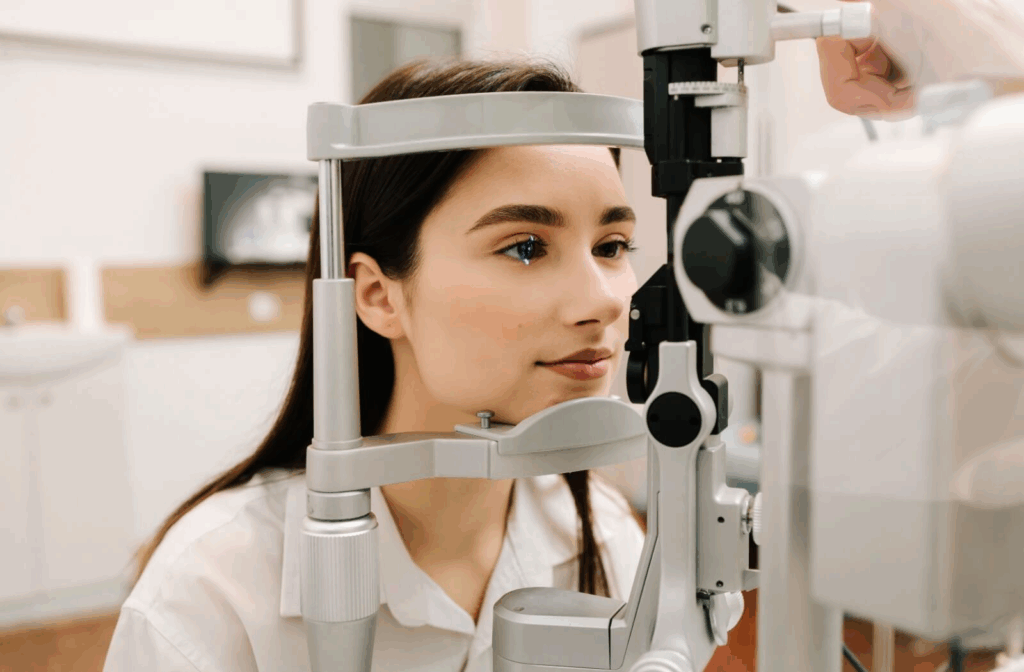Comprehensive eye exams aren’t just for updating your prescription. They’re also important for maintaining general health and well-being. Eye exams don’t just catch eye diseases; they can even detect conditions like cardiovascular disease and brain tumours.
You may have questions about eye exam costs in Alberta. The cost of an eye exam in Alberta can vary depending on the location of the clinic, what services and exams are required, and your insurance coverage. We hope this post offers more insight.
Please note that coverage information can change. The content of this post is based on information available at the time of publication. We recommend double-checking with official sources (eg. Alberta Health, your insurance company) before your appointment. You can also contact your optometry clinic directly for more detailed information.
Eye Care Coverage in Alberta
Many Albertans are covered under the Alberta Health Care Insurance Plan (AHCIP), which offers partial coverage for optometry services within Alberta. Benefit limits and maximums apply.
- Children and youth aged 18 and younger: 1 routine eye exam and 1 diagnostic procedure every benefit year, defined as July 1 to June 30.
- Older adults aged 65 and up: 1 routine eye exam and 1 diagnostic procedure every benefit year. Some older adults may be eligible for additional assistance under the Dental and Optical Assistance for Seniors Program.
- All Albertans: “Medically necessary” eye care from an optometrist. Here are some examples of conditions that may be deemed medically necessary.
Note that optometrists can charge more for covered services if they believe that the service exceeds the AHCIP benefit. You will be responsible for paying these extra costs, but your optometrist should discuss this with you before the treatment.
Recent Changes to Eye Care Coverage in Alberta
There have been some changes to eye care coverage in Alberta as of February 1, 2025. You can find more details about these changes from the Alberta Association of Optometrists (AAO). These coverage changes are more likely to affect those with low vision, special needs, chronic conditions, and rural Albertans, as well as those who may find transportation to multiple appointments challenging.
The AAO recommends contacting your optometrist directly for more information on how these changes will affect you before your appointment.
Factors Affecting Eye Exam Costs
The total cost of an eye exam can vary depending on several factors, including:
- Where the clinic is located
- What tests are required for the patient
- The patient’s private insurance coverage
While Alberta Health doesn’t cover eye exams for adults aged 19 to 64, many working adults receive optometry coverage from their employer or have a private insurance plan that covers eye care services. We encourage you to inquire about your coverage directly with your insurance provider.

Eye Exams: What to Expect
An eye exam isn’t just about updating your eyewear prescription. It’s also an opportunity to screen for eye diseases. Eye exams can even catch some general health concerns, including cardiovascular disease and brain tumours.
Just booked a comprehensive eye exam? Here’s what you can expect:
- Personal health concerns: Your optometrist will discuss your personal and family health history. They may also ask about your visual needs and symptoms
- Visual acuity: Your visual acuity is the sharpness of your vision. Your optometrist will measure this, with and without corrective lenses. If your vision needs correction, your optometrist can provide you with a prescription.
- Other vision assessments: These include tests of binocular vision, depth perception, how your eyes move and coordinate, and more.
- Neurological assessments: These include assessing your peripheral vision and how your pupils react.
- Eye health assessments: These include examining the structures inside and outside your eye.
- Additional testing as required: These can range from retinal photography to colour vision testing.
How to Prepare for an Eye Exam
Not much preparation is required for an eye exam, but you should bring:
- A list of all the medications and supplements you take, prescribed or over-the-counter, even if they don’t seem related to your vision
- Your personal and family medical history, if possible
- Your prescription eyewear and past prescriptions
If you’re expecting a dilated eye exam, you should also arrange for safe transportation home.
Eye Exam Frequency
The Canadian Optometric Association (CAO) recommends the following eye exam frequencies according to age group:
- Babies: A first eye exam between 6 and 9 months of age
- Young children: At least 1 eye exam between the ages of 2 and 5
- Youth ages 6 to 18: 1 comprehensive eye exam every year
- Adults ages 19 to 64: 1 comprehensive eye exam every other year
- Older adults ages 65 and up: 1 comprehensive eye exam every year
Depending on your health, your optometrist may recommend more frequent eye exams. For example, people with diabetes generally require a yearly exam.
Eye Exams in Edmonton
Eye exams are important for everyone, even those with healthy vision. That’s why we strive to be inclusive of everyone who walks through our doors. We value diversity, and our goal is to offer personalized, 1-on-1 care to each patient.Castledowns Vision Centre is a small clinic, but we like to believe we have a big heart! We also accept many insurance providers, including Alberta Blue Cross, Greenshield, and Manulife. If you have questions about coverage or would like to book your next eye exam, don’t hesitate to get in touch.




